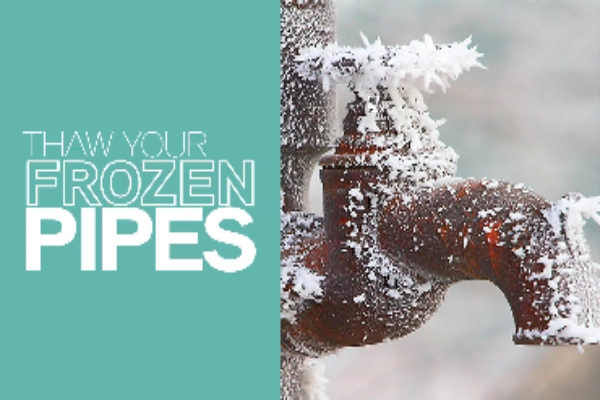
You may have frozen pipes if your pipes are coated in a thin layer of frost or if the gush of water from your faucet is now a mere trickle. Frozen pipes are a definite possibility when thermometers dip, even in regions where winters aren’t harsh.
Follow this guide to thaw frozen pipes and prevent this problem from happening again in the future.
How Cold Does it Have to Be for Pipes to Freeze?
Freezing can happen when the temperature drops below 32 degrees Fahrenheit, but pipes are especially prone to freeze below the threshold of 20 degrees F. Pipes vulnerable to freezing at this temperature are usually located in an unconditioned attic, basement, crawlspace, or along an exterior wall. Underground pipes can also freeze.
How to Thaw Frozen Pipes
If you turn on a faucet and no water comes out, ice may be blocking the plumbing. It’s time to thaw it out. But the technique you use depends on where the ice is located.
For Pipes That are Exposed:
- Open the faucet to relieve pressure as you work.
- Turn off the main water supply in case a pipe has burst. This will prevent a watery mess as you thaw the ice.
- Starting from the faucet side and moving toward the frozen area, slowly heat the pipes with a hair dryer, electric heating pad, heat lamp, or portable space heater. Never use an open flame to thaw frozen pipes, as this can pose a serious fire hazard.
For Pipes Located Behind a Wall:
The simplest technique is to turn up the thermostat and wait. To speed up the process, hold an infrared lamp against the wall. If the situation is dire, you may need to cut a hole in the wall to expose the plumbing, after which you can follow conventional thawing methods for exposed pipes.
For Pipes Located Underground:
Believe it or not, thawing underground frozen pipes doesn’t have to involve digging. Instead, you just need a water jet to blast the ice out of the way from underground. Turn off the main water supply and then follow these steps:
- Place a submersible water pump in a five-gallon bucket of water.
- Attach 1/4-inch plastic ice maker tubing to the pump with the appropriate fitting.
- Attach a four-foot piece of flexible PEX tubing to the pipe in question.
- Feed the ice maker tubing into the PEX tubing until it reaches the blockage.
- Plug the pump into a GFCI outlet to pump a steady stream of water directly at the blockage. As the water hits the ice, it simply trickles back down the pipe and into the five-gallon bucket.
- Once the blockage is clear, pull the tubing back out, turn the main water supply back on, and you’re back in business!
How to Prevent Frozen Pipes in the Future
Frozen pipes are a headache that no homeowner or business owner looks forward to experiencing. Here are a few ways to make sure pipes don’t freeze in the future:
- Have your sprinkler system blown out.
- Disconnect garden hoses from outdoor spigots before winter arrives.
- Open a faucet connected to a vulnerable plumbing line to allow a small trickle of cold water to run all night.
- Open under-sink cabinets to allow warm air to circulate around the pipes.
- Never set the thermostat lower than 55 degrees, even if you’re out of town.
- Insulate exposed piping on external walls.
Let Mr. Rooter® Plumbing Help Thaw Your Frozen Pipes
If you attempt these methods and still can’t thaw the ice in your plumbing, Mr. Rooter Plumbing can help. Our experienced plumbers can also repair burst pipes to get your plumbing up and running again. Give us a call or search for your local Mr. Rooter to get help with thawing your frozen pipes.

